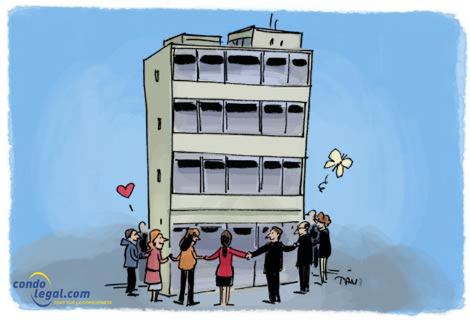Co-ownership fraction

In divided co-ownership, the property of the building is divided among the co-owners in the form of "fractions." Each fraction includes a clearly defined private section, such as an apartment, a parking space, a storage unit, or even sometimes a piece of land. Additionally, each fraction grants a share of the common portions and, in some cases, an exclusive right of use to certain common portions. In other words, a fraction of co-ownership is the result of dividing a building into several lots. All of these fractions together form the entirety of the building, as described in the declaration of co-ownership.
Composition of a co-ownership fraction
Each fraction may be alienated in whole (e.g., sale to a third party) or in part (e.g., a co-owner sells an undivided percentage of his apartment to his or her spouse). However, the fraction is made up of two elements that cannot be transferred separately. These elements are:
- One or more private portions; ;
- An undivided share of the common portions (e.g., lobby, corridors, stairs, land surrounding the building, etc.).
Each fraction also forms a distinct entity for the purpose of property assessment and taxation. The syndicate of co-owners shall be impleaded in case of any judicial dispute concerning the assessment of a fraction by a co-owner.
Share in the common portions
The share represents the part of the undivided ownership that each co-owner holds in the common portions. This right of ownership is determined in accordance with the relative value of each fraction. The share is generally expressed as a percentage or thousandth, in the constituting act of the co-ownership.
Relative value
The relative value represents the value of a specific fraction (e.g. apartment 303), compared to the total value of the fractions. Generally expressed in percentage or in thousandths, it is established by taking into account the nature, destination, dimension and location of the private portion of each fraction, but without taking its use into account. It establishes the share of the right of ownership of the co-owners in the common portions, their contribution to common expenses and the number of votes attached to their private portion.
Resale ban
The alienation of a divided part of a private portion is without effect if the declaration of co-ownership and the cadastral plan have not been previously amended to:
- Create a new fraction;
- Describe it;
- Give it a separate cadastral number;
- Determine its relative value;
- Record, if necessary, the alterations of the boundaries between contiguous private portions.
Thus, a co-owner who would like to split his apartment into two apartments, in order to sell them separately, should follow the procedure described above.
Where two private portions (e.g., an apartment and a parking box) are part of the same fraction, a co-owner cannot sell them separately. If he wishes to do so, he must first have an amendment to the declaration of co-ownership prepared and have it adopted by the assembly of the co-owners.
Using a co-ownership fraction
In principle, each fraction can be used by the co-owner as he sees fit. However, he can only use and enjoy his private and the common portions on the condition of complying with the by-laws of the immovable and if he does not impair the rights of the other co-owners or the destination of the immovable.
He must obtain permission from the meeting of the co-owners if he wants to modify or annex the common portions or the common portions for restricted use (e.g. a balcony). If he does not do so, the Board of Directors will have to require the co-owner who has taken such an initiative to return the premises to their original condition (and at his own expense).
 WHAT YOU SHOULD KNOW! When you buy an apartment in a divided co-ownership building, you become the owner of your dwelling (private portion), but you also own an undivided part of the building called the common portion (e.g. land, balconies, large works of the building such as exterior walls and roof). This set, composed of the private portion and an undivided right in the common portion, is called in legal jargon: fraction.
WHAT YOU SHOULD KNOW! When you buy an apartment in a divided co-ownership building, you become the owner of your dwelling (private portion), but you also own an undivided part of the building called the common portion (e.g. land, balconies, large works of the building such as exterior walls and roof). This set, composed of the private portion and an undivided right in the common portion, is called in legal jargon: fraction.
 WHAT TO KEEP IN MIND:
WHAT TO KEEP IN MIND: The fractions are described in the declaration of co-ownership, in the chapter entitled
Description of fractions, and are materially identifiable. A fraction may have one or more private parts. It may include an apartment, but also a parking space or a parcel of land (e.g. town houses)
 WARNING!
WARNING! An apartment and a parking space cannot be sold separately when they are a single fraction, even if they have their own lot number.
Back to the factsheets




